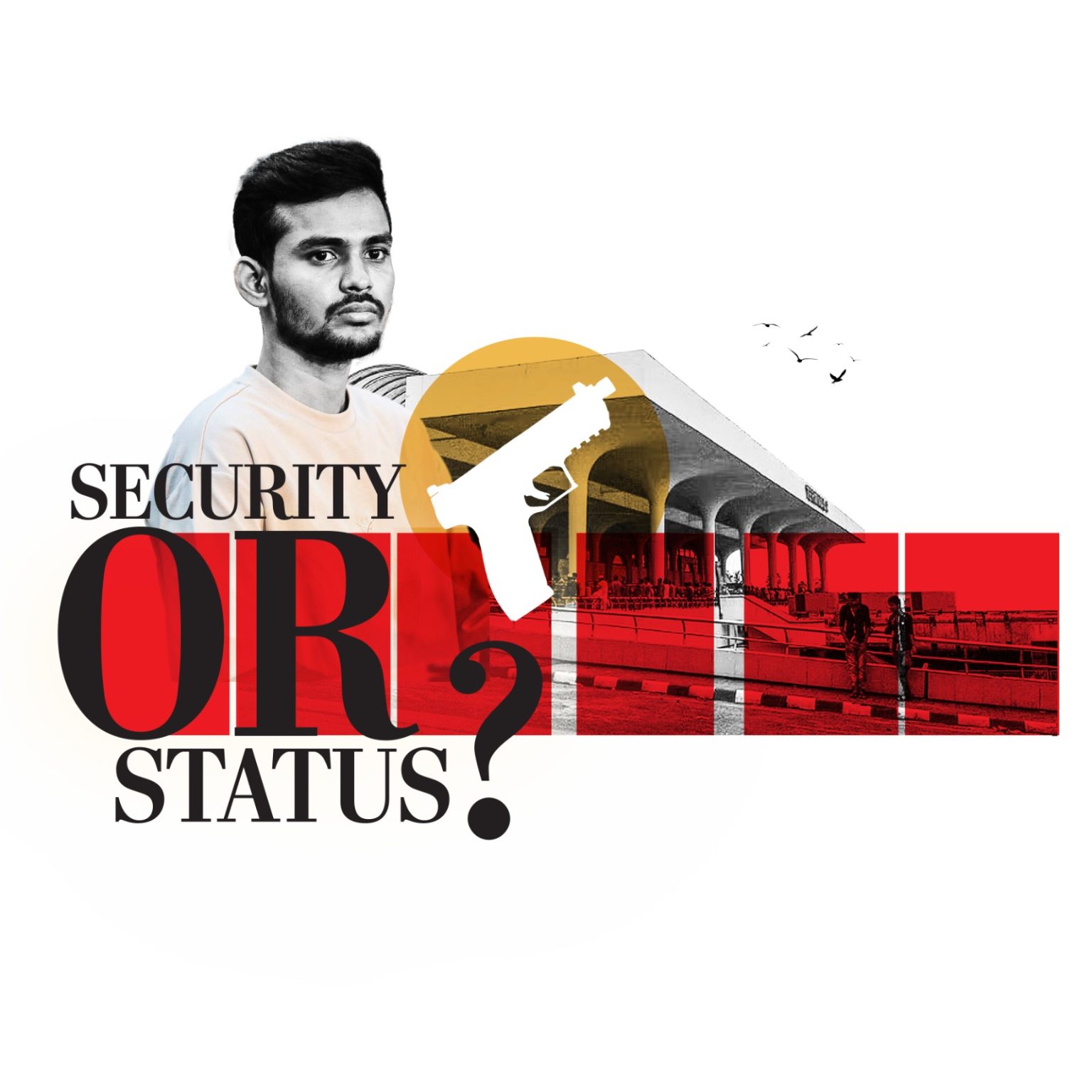The recent uproar surrounding Adviser Asif Mahmud’s possession of a licensed firearm has gone far beyond a routine issue of gun ownership. At the heart of the public debate lies a question that blends legality, privilege, and perception: Is Asif’s gun a legitimate tool of self-defence or a symbol of political entitlement?
The controversy intensified following an incident at Hazrat Shahjalal International Airport in Dhaka, where the security personnel discovered a loaded magazine—an ammunition clip—in Asif’s carry-on luggage as he was enroute to Morocco for an international event. Although no weapon was recovered at the scene, the presence of ammunition raised immediate alarm. Was the ammunition licensed? Was it being transported lawfully? And, most importantly, how did someone of Asif’s age and background acquire a gun licence in the first place?

Legal pathways and questioned privilege
Under the Firearms Licence Issuance, Renewal, and Usage Policy 2016, the rules governing civilian gun ownership in Bangladesh are clear but strict. A citizen must be between 30 and 70 years of age, physically and mentally fit, and a documented taxpayer for the past three consecutive fiscal years. Additionally, they must demonstrate a valid reason for possessing a firearm, such as personal security or occupational need.
Asif Mahmud, an adviser to the caretaker government with responsibilities under the ministries of youth and sports and the local government, does not meet these standard requirements. He is under the age threshold and was, until recently, a student. It is therefore highly unlikely that he has a three-year record of tax payment.
Yet, he holds a legal gun licence. How?
The answer lies in Clause 32 of the same 2016 firearms policy. This clause offers a legal, but controversial, loophole. It exempts a specific class of individuals from meeting the typical criteria. These include ministers and those holding equivalent rank, Members of Parliament, city corporation mayors, judges, high-ranking civil and military officials, and nationally recognised figures in arts, culture, science, or sport.
By virtue of his ministerial rank in the interim government, Asif falls under this category. So legally, he qualifies. But public criticism is less about legality and more about perceived favouritism and ethical boundaries. If the law is intended to ensure firearms are in the hands of responsible, vetted individuals, critics argue, then such broad exemptions undermine the very purpose of the policy.
The airport incident is the tipping point
While Asif’s licence may have escaped major scrutiny under normal circumstances, the airport incident brought his firearm ownership into sharp public focus. The ammunition discovery triggered a flurry of questions: Was it part of his licensed firearm? Why was the weapon not declared or documented for travel? And why was ammunition in his carry-on at all?
Authorities began investigating, but the incident had already gone viral, fuelling widespread media coverage and social media commentary. It also reopened a broader discussion about how firearms are regulated (and occasionally misregulated) in Bangladesh.
Asif’s defence: A matter of safety
Amid mounting criticism, Asif took to Facebook to defend his position. In a public post, he stated that his firearm was legally licensed and kept solely for personal protection. He cited multiple threats to his life and alleged assassination attempts due to his involvement in political activism and leadership roles in protest movements.
In the absence of consistent government-provided security, Asif argued that possessing a firearm was not only justified but necessary.
His defence touched on a valid concern: the gaps in personal security for politically active individuals who lack formal state protection. But it also opened another line of questioning—should individuals, regardless of their political involvement, be allowed to rely on personal weapons for protection in place of state mechanisms? Should increased threat assessments not result in more government-assigned security rather than private armament?
Security or status?
This is where the core of the controversy lies. Is the firearm a necessary tool for survival amid political instability, or does it serve as a status symbol, reinforcing the narrative that political connections bring special privileges?
Bangladesh has around 50,000 licensed firearms in circulation, according to the Special Branch of Police. Yet enforcement of firearm policy remains patchy. While ordinary applicants must endure multiple stages of scrutiny, including police verification, interviews, and Home Ministry approval, individuals with influence can gain access via exemptions.
This disparity creates a two-tier system: one for the general public and one for the elite. In such a context, even a technically legal licence, when issued under special provisions, begins to look like a symbol of entitlement rather than a measure of necessity.
Broader implications for policy and trust
The Asif Mahmud case has highlighted the fragility of public trust in the licensing system. Questions are now being raised not only about individual eligibility but about the structure and fairness of the policy itself. Should Clause 32 be revised or made more transparent? Should there be mandatory public disclosure or auditing of special-category licences? And should threats to personal safety be addressed through policy reform rather than individual arming?
Legal experts and civil society groups have begun calling for a review of the firearms policy, particularly the clauses that allow exemptions. Others have pointed to the need for greater oversight and accountability mechanisms to prevent misuse, especially by public figures.
The controversy over Asif Mahmud’s gun possession is not just about a young political figure with a firearm. It is about the credibility of laws, the unequal access to protection, and the ethics of privilege in governance. Whether his weapon is a genuine safeguard or a political symbol, the debate it has triggered is long overdue.
As the nation wrestles with questions surrounding law and security, perhaps less for protection than for the blurred line between public duty and personal power, the adviser’s gun remains a powerful metaphor.


